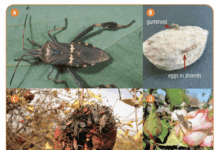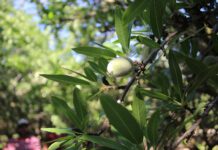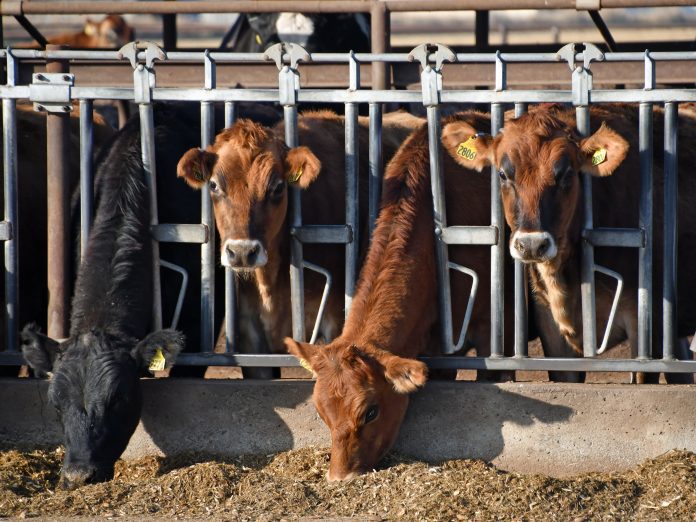
Almond hulls, once a low-value byproduct, have enjoyed renewed popularity as dairy producers look for more economical alternatives to flaked corn and corn silage as ration ingredients.
“Almond hulls have been incorporated into dairy diets for decades now,” said Jennifer Heguy, UCCE dairy farm advisor for Merced, Stanislaus and San Joaquin counties. “We know from our survey of the dairy cattle nutritionists that almond hulls are versatile and are used as a concentrate replacement as well as a forage.”
As the ongoing drought has decreased water deliveries, an increasing number of dairy nutritionists have looked to almond hulls to replace at least some corn silage. More recently, Heguy said, rail delivery delays have affected the price and availability of Midwestern corn, with steamed-flaked corn being a major concentrate ingredient in dairy diets. However, almond hulls can fill the bill as a concentrate.
How widely almond hulls are used in dairy rations and how much producers can feed to lactating cows each day without affecting milk yield were the subjects of research begun in 2019. Dr. Ed DePeters, distinguished professor of animal science; Dr. Katie Swanson postdoctoral researcher in animal science; and Heguy collaborated on this work.
Almond hulls comprise about 50% of the almond tree fruit weight, depending on the variety and the year. With USDA forecasting a roughly 2.6-billion-pound almond crop this year, that could amount to about 5.2 billion pounds of hulls. At the same time, California had about 1.77 million head of dairy cattle as of July, according to USDA figures.
Almond Hull Use
Along with Jed Asmus, a dairy nutritionist with January Innovations Inc., Heguy, DePeters and Swanson surveyed the California chapter of the American Registry of Professional Animal Scientists in 2019.
Of the 42 respondents, the majority said they used almond hulls as both a concentrate and a forage for lactating cows. Concentrate ingredients are low-fiber, high-energy feed ingredients that are high in sugars or starches, whereas forages are high-fiber ingredients such as silage and hay.
Respondents said they fed an average of 5 pounds of hulls per cow per day, and 41% said they had increased the amount of almond hulls in their rations during the past five years.
Their opinions were similar whether they worked with Holstein or Jersey cattle, the two most common dairy breeds in the state.
But about 62% of respondents said changes in almond hull prices affected how they used them in ration formulations. When asked what factors they prioritized when including a product in rations, they said pricing was their top consideration, followed closely by consistency.
Dairy nutritionists formulate rations based on the nutrient and energy concentrations of each feed ingredient, and several feeds are combined to make a diet. The recipe may vary depending on commodity prices and availability. Much like a human diet, they have to balance energy with fiber and protein. Vitamin and mineral content of each ingredient also is factored in.
Heguy said she hasn’t conducted a follow-up survey and was waiting until possibly next year to see if current educational outreach efforts changed almond hull use.
But DePeters said he suspects their usage may be higher now for two reasons. “Almond hulls are a unique feedstuff,” he said. “Almond hulls can be used as a forage ingredient and a concentrate ingredient. The rail issues into California have impacted the availability and price of corn grain. Steam-flaked corn is a major concentrate ingredient in dairy diets. Almond hulls, because of their high sugar content, are replacing some flaked corn (high starch). I say replace, but there are other aspects involved. How the starch and the sugars ferment in the rumen is different based on my reading.”
The good news, DePeters said, is the sugars in almond hulls may put less stress on rumen pH than the starch in corn, and they are evaluating that in a feeding study of almond hulls and alfalfa in cubed form they just completed.
Almond Hull Feeding Trials
Although dairy nutritionists surveyed reported using an average of 5 pounds of almond hulls per cow per day in their rations, the researchers wanted to determine the impacts of feeding high amounts of hulls, higher than the average 5 pounds per cow. Their trial included 12 lactating Holsteins, and the treatments were 0, 4, 8 or 12 pounds of almond hulls per cow per day. The hulls were used as a concentrate, offsetting portions of flaked corn and soy hulls.
The researchers then measured milk yield, milk composition, feed intake, rumination activity and diet digestibility. They found no significant differences in feed intake and milk yield.
Where they did find differences were in the milk composition. As the cows ate more almond hulls, the percent of milk fat increased while the percent of milk protein and pounds of milk protein decreased.
The two highest amounts of almond hulls also lengthened rumination, or cud chewing, by 60 minutes per day, which may lead to a more stable and desirable rumen environment, Heguy said.
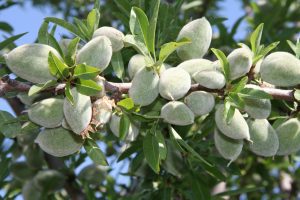
Sticks and Shells
About two-thirds of survey respondents also expressed concerns about feeding almond hulls to lactating cows, with the biggest concern being the quality related to the amount of sticks and shells. The vast majority of respondent (80%) tested almond hulls, but the frequency of testing varied widely from every load to only when problems arose.
CDFA randomly samples almond hulls to ensure they meet the state definition of “almond hull products” in the Food and Agricultural Code.
Commercial feed law 2773.5 states that hulls “shall not contain more than 13% moisture nor more than 15% crude fiber and not more than 9% ash.”
Although almond hulls naturally contain some crude fiber that varies among varieties, having an excessive amount of sticks and shells, which are high in crude fiber, can put a load over the limit of 15% crude fiber.
From 2014 and 2018, the state analyzed 673 almond hull samples. Of those, between 39% and 62% exceeded the crude fiber limit. Loads found in violation could still be sold as “almond hull and shell,” which California defines as “more than 15% but less than 29% crude fiber.”
Hull Variability
To demonstrate hull variability, the researchers obtained 12 samples of almond hulls from commercial hullers. Five were Nonpareil hulls while seven were from pollinator varieties. They hand sorted the samples, separating the hulls from debris (stick and shell).
The Nonpareil samples averaged 4.8% debris while the pollinator samples averaged 6.8% debris.
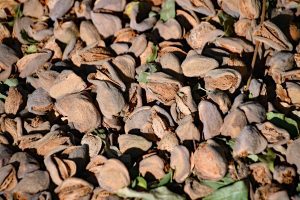
They also analyzed the raw samples from the hullers, the hand-sorted pure hulls and the debris for chemical composition. What they found were the sticks and shells decreased sugar and energy content significantly while increasing fiber content.
Although the Nonpareil samples averaged below the state limit of 15% crude fiber on an as-is basis, which includes moisture, the pollinator samples exceeded the state limit. The chemical analysis also showed differences among varieties and even among labs used for testing.
Nevertheless, the researchers found almond hulls were an excellent source of highly digestible sugars, and Nonpareil hulls were superior in nutritional value to pollinator hulls.




